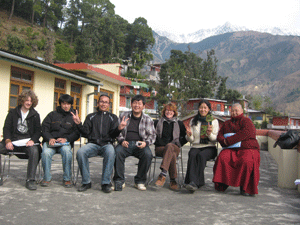I had made all the excuses I could think of to not learn Tibetan – I’m entering menopause and my hormones are erasing my memory; I don’t have time; I’ve never had a propensity for languages. (I took five years of French at school and can remember about three sentences and have only some broken Spanish to show for twenty years in Los Angeles.) My last, and I thought, best excuse, was that the Tibetan language is simply too hard. For starters, you need to learn a whole new alphabet, with sounds that you’ve never made in your life, except involuntarily during a nasty cold.
But after three years of living in Dharamsala, India, the capital of the exiled Tibetan community, I began to feel increasingly embarrassed that I could say little more than “Hello,” “How are you?” and “The electricity is out.” (Useful in a place where power cuts are almost as frequent as commercial breaks.)
I had attended a couple of Tibetan language classes, admittedly rather half-heartedly, and had dropped out after only a couple of weeks, feeling even more convinced of my innate inability to grasp this language.
When learning Tibetan, you come to realize the magnanimity of the English language. Crazy as English is, with its whacky spelling and endless rule exceptions, you can speak English with the wildest of accents; from Zsa Zsa Gabor to Inspector Clouseau to George Bush Junior, and still be understood. The English say ‘water,’ Americans say ‘wadder’ and no one has to flag down a translator. But Tibetan is unforgiving. If you don’t pronounce a word in exactly the correct way, you’ll get a blank stare in response.
It doesn’t help that people from different regions of Tibet speak in such distinct dialects that even some Tibetans have trouble understanding one another. And of course, everyone thinks that their dialect is the correct one. You will say something in a Lhasa dialect and someone from Kham will insist that you’re wrong. But if you say it the Kham way, then someone from Amdo is sure to say, “No, no, no, that’s not how you say it.”
Another thing about Tibetan is that words that sound identical to a Westerner often have entirely different meanings. Of course, we also have lots of these in English. They’re called homonyms – so and sew, by and buy, through and threw, and so on. But the problem is that the words I’m referring to are not homonyms (although Tibetan has those too). To us they might sound the same, but to the Tibetan ear they are clearly distinct.
Most non-Tibetans struggle to hear the difference, for example, between the Tibetan words for ice, fat and crap. (You can imagine the possibilities for trouble, like when a friend of mine tried to say there was a lot of ice on the road and sent a vanload of monks into hysterics.) And there are dozens of examples of these, such as the words for ‘Buddhist teachings’ and ‘toilet,’ the words for ‘hot’ and ‘thin,’ and ‘house’ and ‘leg.’ Tibetans will patiently say the word for leg and the word for house over and over, while you do your level best to understand and repeat back the difference. After every attempt you make, they will shake their head and say it again, and you will think to yourself, “But that’s what I just said!” You will keep repeating what you heard them say, and they will keep shaking their head, until you start to wonder if they’re joking with you.
Many of the things we were learning to say in class (“The dog is white, Those are oranges”) seemed to have little applicability to natural conversation, and some were very culturally specific. It was difficult to imagine when you would have cause to say, “The naga resides in that pond” (nagas being water spirits). Tibetan grammar bears no resemblance to English, and I just couldn’t seem to get my head around it (although later I discovered that the odd syntax of Yoda’s character in Star Wars had been modeled on the Tibetan language). When in doubt about the order of verb/object/predicate/preposition, it proved very helpful to ask myself, “What would Yoda say?”
A few months after leaving this class, still feeling too shy to try to strike up a conversation in Tibetan lest someone reply with, “I know those are oranges, do you think I’m stupid?” I saw a flier for a twenty-day intensive Tibetan language course. I decided to give it one more crack.
Our teacher, Dr. Chok Tenzin Monlam, the head of the library’s research and translation department, was a former monk who was developing his own system of teaching Tibetan to foreigners, learning from the successes and failures of the past. He had so much enthusiasm and optimism that even the monotony of pronunciation drills became fun in his classroom. We were an eclectic mix: a Japanese philosopher, a Russian nun, an Italian dharma student, a Taiwanese human rights activist, an American high school teacher and myself. With Chok’s encouragement, my confidence found a foothold, and slowly, slowly, it began to sink in. I even began to distinguish between ‘leg’ and ‘house.’
I may never be able to discuss the meaning of life in Tibetan or debate international politics, but I can chat about the weather, ask people about their children, and engage in basic shop talk. Of course, I still sometimes get discouraged. Like when my cell phone dropped a call with a Tibetan friend the other day, and I phoned her back and told her in Tibetan that my phone connection was crap. “Your phone is fat?” she replied.
Rebecca Novick is the founding producer of The Tibet Connection radio program, online at: thetibetconnection.org.
By Rebecca Novick

